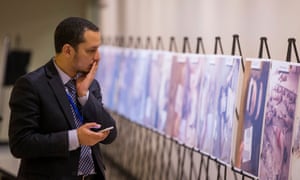'The Syrian north witnessed on Friday major demonstrations in the cities and towns of Idlib and suburbs of Aleppo and Hama in a Friday called "Rejection of the Russian aggression," denouncing the recent statements made by the international envoy, "Staffan deMistura," and to emphasize the people support the revolutionary factions and their decisions.
There were demonstrations of Idlib residents and rebels in the areas of Sarmada, Idlib city, Sarqib, Ghadfa, Habit, Bennish, Ma'rat al Shlaf, Ma'arat al-Nu'man, Al-Dana, Jirjanaz, Ma'arShurin, Kifroma, Harem, Kafraweid, Ma'arat Mater, Khan Shikhun, Ariha, Jisr al-Shoughour, Kafranbel, Ma'arat Misreen, al-Teh and Jbala.
Demonstrators in Idlib confirmed their rejection of reconciliation and acceptance with what they called the occupation "in reference to Russia" and their stand in support of the factions' decision to repel any upcoming attacks. They also raised a group of banners say that Idlib is strong and both the military and political factions are supported by the residents of the region completely.
In the city of al-Dana, which also witnessed demonstrations as some children carried figures in the form of frogs as an expression of their rejection of the advocates of surrender and confirmation that the Syrian revolution is the only way to them.
As for the countryside of Aleppo where people came out and the rebels in each of the areas of Atarb, A'zaz, Jarabulus, al-Bab, Baza'a, Anadan, Darat Ezza, Anjara, al-Eis, al-Zerba, and Abin Sam'an as slogans blamed de Mistura for his own demands to open humanitarian corridors, calling his as a partner in the aggression against the people asserting that they do not need a human path rather than they need a humanitarian situation. Another demonstration took place in the city of Morek in rural Hama.
The statements made by the international special envoy to Syria, Staffan de Mistura, have aroused great discontent among the rebels and the civil activities, especially because of his adoption of the regime and Russia's novel about Idlib and accusing the revolutionary factions of possessing chemical weapons. He said that the province includes about 10,000 "terrorists" ,calling at the same time for establishing a humanitarian corridor allows civilians to leave and this is what is sought by both Moscow and the Assad regime.
Commenting on the words of the envoy, the organization "Response Coordination Group" specialized in follow-up of the displaced in Syria, called on the international community to end the mandate of "Staffan de Mistura" and search for another one to end the suffering of civilians, considering that the statements of the envoy is not different from the statements of the Russian Foreign Minister or the regime itself, as the organization sees that he is an employee of both Russia and the Syrian regime and works to get them out of the crises that plague them.
The Muslim Brotherhood in Syria condemned the remarks of de Mistura and considered that he turned with the United Nations to "promoters for a military attack on millions of civilians in Idlib," noting that this is "the summit of international failure to prevent the protection of innocent people displaced by the violation of the De-escalation Zones agreements by the Russian occupation.
Activists described de Mistura as the spokesman for the Syrian regime's army. Among the comments, activist Wael Abdel Aziz posted a picture of the envoy behind a platform reading "The General Command of the Army and the Armed Forces," saying that it is a leaked picture of de Mistura is believed to have taken last comments directly , which justified and legitimized the attack of Russia, Iran and the Assad regime on the liberated north, and likely the picture from the statement of his announcement of zero hour to start the attack.
The Syrian regime and its militias have brought military reinforcements over the past two weeks to the villages of Hama in preparation for the attack on Idlib. They also set up an operations room to manage the battle. In return, the revolutionary factions announced that they had finished preparing their defensive and offensive plans and become ready to repel any operations that might target the villages of Lattakia, Hama and Idlib.
Turkish Defense Minister Khulosi Akkar confirmed that his country is exerting efforts to prevent attacks on the city of Idlib and to ensure the safety of 4 million people, adding that his country has 12 monitoring posts to maintain the agreement of de-escalation zone.'


